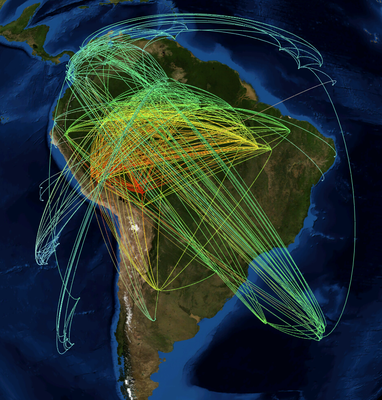Project 11
Creating complex networks to represent and characterize climate
|
Extreme weather events have gained great attention in climate impact research due to their particular importance for society. The first part of this project focusses on the analysis of the spatiotemporal characteristics of extreme rainfall in the South American Monsoon System (SAMS) by means of complex networks. The networks are constructed from correlation matrices, obtained by synchronizing events at different locations (Figure 1 shows the most important links of such a network). The spatial distribution of various network measures reveals many known features of the SAMS, such as convergence zones, regions with strong convection and major moisture transport routes (Figure 2 shows the network's degree centrality at each grid point). We investigate the seasonal variations in these patterns and put them into relation to the known characteristics of the monsoon systems. Interannual variations in the network patterns corresponding to different states of the El Niño Southern Oscillation (ENSO) or the Madden-Julian Oscillation (MJO) are investigated and compared to recent results on the interplay of ENSO and MJO and the occurrence of extreme rainfall events. Hereafter, the interplay of precipitation and other climate observables such as sea surface temperatures and evapotranspiration rates will be studied and represented by multivariate networks. Here, many open methodological questions remain concerning the choice of a suitable correlation measure and the procedure of coupling the subnetworks. The impact of oceanic oscillations such as ENSO or MJO as well as of global warming on the regional and global climate system will be accounted for in the context of of a general framework for the analysis of the temporal evolution of univariate as well as multivariate climate networks. |
Figure 1
Figure 2 |


